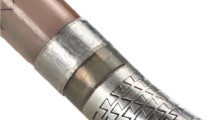Summary
Outpatient radiofrequency catheter ablation has been shown to be safe and cost effective in the treatment of supraventricular tachycardias due to atrioventricular nodal reentrant tachycardia and atrioventricular reentry tachycardia. Complications secondary to vascular access are similar to those during outpatient cardiac catheterization procedures. Specific complications due to catheter manipulation and radiofrequency ablation include among others cardiac tamponade, AV block and proarrhythmia. Proper patient selection can help to prevent specific complications in outpatient ablations. Patients probably not suitable for outpatient procedures include the elderly as well as comorbid patients. Not all ablation procedures are suitable for the outpatient setting. Ablation procedures with an increased risk of AV block or proarrhythmia should not be performed on an outpatient basis. In order to effectively perform outpatient procedures a back up support with specially trained personnel is helpful. Radiofrequency ablations require considerable experience, therefore ablation procedures in the outpatient setting should be restricted to operators with adequate experience.
Zusammenfassung
Für die ambulante Katheterablation supraventrikulärer Tachykardien mit Hochfrequenzenergie konnte gezeigt werden, daß die Eingriffe bei der AV-Knote-Reentry-Tachykardie sowie bei der AV-Reentry-Tachykardie mit einem hohen Maß an Sicherheit und Kosteneffizienz durchgeführt werden können. Komplikationen, die im Rahmen des vaskulären Zugangs entstehen, entsprechen zum großen Teil denen der ambulanten Herzkatheteruntersuchung. Spezielle Komplikationen, die bei der Kathetermanipulation und der Ablation mit Hochfrequenzenergie entstehen können, beinhalten Perikardtamponade, AV-Blockierung sowie proarrhythmische Ereignisse. Mit Hilfe einer konsequent durchgeführten Patientenselektion können diese Komplikationen bei ambulanten Eingriffen größtenteils verhindert werden. Ältere sowie komorbide Patienten sind für eine ambulante Katheterablation nicht geeignet. Auf der anderen Seite sollte auch eine Selektion hinsichtlich der zu behandelnden Rhythmusstörung erfolgen. Eingriffe mit erhöhtem Risiko für AV-Blockierung oder Proarrhythmier sollten lediglich unter stationären Bedingungen durchgeführt werden. Um eine effektive und sichere Katheterablation von Rhythmusstörungen unter ambulanten Bedingungen zu gewährleisten, ist eine Überwachungseinheit mit speziell trainiertem Personal notwendig. Katheterablationen erfordern ein hohes Maß an Erfahrung. Daher sollten ambulante Ablationen lediglich von Untersuchern mit entsprechender Erfabrung durchgeführt werden.
Similar content being viewed by others
References
Block P, Ockene I, Goldberg R, et al. A prospective randomized trial of outpatient versus inpatient cardiac catheterization. N Engl J Med 1988;319:1251–5.
Calkins H, Sousa J, El-Atassi R, et al. Diagnosis and cure of the Wolff-Parkinson-White Syndrome or paroxysmal supraventricular tachycardias during a single electrophysiologic test. N Engl J Med 1991;324:1612–8.
Chen S, Ching C, Yang C, et al. Accessory pathway and atrioventricular node reentrant tachycardia in elderly patients: clinical features, electrophysiologic characteristics and results of radiofrequency ablation. J Am Coll Cardiol 1994;23:702–8.
Deshpande S, Bremner S, Sra J, et al. Ablation of left free-wall accessory pathways using radiofrequency energy at the atrial insertion site: transseptal versus transaortic approach. J Cardiovasc Electrophyciol 1994;5:219–31.
Epstein L, Chiesa N, Wang M, et al. Radiofrequency catheter ablation in the treatment of supraventricular tachycardia in the elderly. J Am Coll Cardiol 1994;23:1356–62.
Geelen P, Brugada J, Andries E, Brugada P. Ventricular fibrillation and sudden death after radiofrequency catheter ablation of the atrioventricular node. PACE 1997;20:343–8.
Hindricks G. Incidence of complete atrioventricular block following attempted radiofrequency catheter modification of the atrioventricular node in 880 patients. Eur Heart J 1996;17:82–8.
Jackman W, Wang X, Friday K, Roman C, Moulton K, Beckman K, McClelland J, et al. Catheter ablation of accessory atrioventricular pathways (Wolff-Parkinson-White-Syndrome) by radiofrequency current. N Engl J Med 1991;324:1605–11.
Kadish A, Calkins H, de Buitleir M, Morady F. Feasibility and cost savings of outpatient electrophysiologic testing. J Am Coll Cardiol 1990;16:1415–9.
Kalbfleisch S, Calkins H, Langberg J, et al. Comparison of the cost of radiofrequency catheter modification of the atrioventricular node reentrant tachycardia. J Am Coll Cardiol 1992;19:1583–7.
Kalbfleisch S, el-Atassi R, Calkins H, Langberg J, Morady F. Safety, feasibility and cost of outpatient radiofrequency catheter ablation of accessory atrioventricular connections. J Am Coll Cardiol 1993;21:67–70.
Kosinski D, Grubb B, Burket M, Durzinsky D. Occlusion of the left main coronary artery during radiofrequency ablation for the Wolff-Parkinson-White Syndrome. Eur J CPE 1993;1:63–6.
Kuck K, Schlüter M, Geiger M, Siebels J, Duckeck W. Radiofrequency current catheter ablation of accessory atrioventricular pathways. Lancet 1991;337:1557–61.
Lesh M, van Hare G, Schamp D, et al. Curative percutaneous catheter ablation using radiofrequency energy for accessory pathways in all locations: result in 100 consecutive patients. J Am Coll Cardiol 1992;19:1303–9.
Lesh M, van Hare G, Scheinman M, Ports T, Epstein L. Comparison of the retrograde and transseptal methods for ablation of left free wall accessory pathways. J Am Coll Cardiol 1993;22:542–9.
Man K, Kalbfleisch S, Hummel J, et al. Safety and cost of outpatient radiofrequency catheter ablation of the slow pathway in patients with atrioventricular nodal reentrant tachycardia. Am J Cardiol 1993;72:1323–4.
Minich L, Snider A, Dick MI. Doppler detection of valvular regurgitation after radiofrequency ablation of accessory connections. Am J Cardiol 1992;70:116–8.
Morady F, Hasse C, Strickberger S, et al. Long-term follow-up after radiofrequency modification of the atrioventricular node in patients with atrial fibrillation. J Am Coll Cardiol 1997;27: 113–21.
Natale A, Wathen M, Yee R, Wolfe K, Klein G. Atrial and ventricular approaches for radiofrequency catheter ablation of leftsided accessory pathways. Am J Cardiol 1992;70:114–6.
Scheinman M. Patterns of catheter ablation practice in the united states: results of the 1992 NASPE survey. PACE 1994;17:873–5.
Schlüter M, Kuck K. Radiofrequency current therapy of supraventricular tachycardia: accessory atrioventricular connections. PACE 1993;1993:643–8.
Schwartz J, Tracy C, Fletcher R. Radiofrequency endocardial catheter ablation of accessory atrioventricular pathway at atrial insertion sites. Circulation 1993;87:487–99.
Seifert M, Morady F, Calkins H, Langberg J, Aortic leaflet perforation during radiofrequency ablation. PACE 1991;14:1582–5.
Warrin J, Haissaguerre M, D’Ivernois C, le Metayer P, Monserrat P. Catheter ablation of accessory pathways: technique and results in 248 patients. PACE 1990;13:1609–14.
Williamson B, Man K, Daoud E, Niebauer M, Strickberger S, Morady F. Radiofrequency catheter modification of atrioventricular conduction to control the ventricular rate during atrial fibrillation. N Engl J Med 1994;331:910–7.
Author information
Authors and Affiliations
Corresponding author
Rights and permissions
About this article
Cite this article
Bogun, F., Morady, F. Outpatient radiofrequency catheter ablation. Herz 23, 42–46 (1998). https://doi.org/10.1007/BF03043011
Issue Date:
DOI: https://doi.org/10.1007/BF03043011




